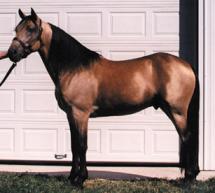
|
Return to Breed Profiles Main Page
The Missouri FoxtrotterThe hallmark
of the Missouri Fox Trotting Horse is the Fox Trot, an extremely
sure-footed, smooth gait, that can be maintained over long distances
without tiring the horse. It is a broken diagonal gait in which
the front legs exhibit a long reach and the rear legs glide into
place, often "capping", or overstepping the front track. The rhythm
is unmistakable as the front foot hits the ground a Fox Trotters also perform a fast, rhythmic flat walk and a rolling canter. A distinct
breed since
Many breeds have been credited with contributing to Missouri Fox Trotter bloodlines. From the available plantation horses of the region at the time, including Narragansett and Canadian Pacers, to horses from what were to become American Saddle bred, Standard bred and Tennessee Walking Horse lines, to Morgan, Thoroughbred and Arabian strains, breeders chose the best of what was available to eventually establish the Missouri Fox Trotting Horse we know today. No concrete conformation Because it is
relatively new as a breed and because of the variable influences
that went into developing the Missouri Fox Trotter, there is no
concrete "type." Conformation tends to range from stock horse type
to Morgan, etc., but the overall appearance should always be one
of balance, athleticism and agility. Height ranges from 14 to 16
hands, weight around 1000 pounds. A versatile horse The Missouri Fox Trotting Horse Breed Association was formed in 1948, to preserve the breed. As the breed grew in popularity the association was reorganized in 1958. In 1981 the American Horse Show Association officially recognized the breed and began offering specific classes for horses to be shown in two or three gaits (including canter). Today appreciation for the breed has escalated with nearly 50,000 horses registered throughout the U.S. Canada, Austria and Germany. The national headquarters remains near Ava, Missouri, where annual shows and celebrations are held. |
|||

 split second before the opposite (diagonal) rear foot. The break
in rhythm may be somewhat variable from horse to horse.
split second before the opposite (diagonal) rear foot. The break
in rhythm may be somewhat variable from horse to horse.